The National Council of Architectural Registration Boards (NCARB) has released its ninth annual report, offering a snapshot of the profession in 2019 through the lens of licensing, education, and other metrics. This year, the report includes expanded demographic information, an exploration of exam pass rates, and early findings of a survey conducted in partnership with the National Organization of Minority Architects on equity, diversity, and inclusion in licensure.
Total Professionals
The number of architects in the U.S. increased by 1 percent from 2018 to 2019, for a total of 116,000 licensed practitioners at the start of 2020. However, only 3,968 designers completed the three core requirements for licensure—education, experience, and examination, and an indicator that an individual has, or soon will, become licensed—in 2019, down 20 percent from the year before. NCARB attributes this drop to the previous several years of high completion volumes, including a record high in 2017, and a smaller pool of candidates in 2019. (In June 2018, version 4.0 of the Architect Registration Examination (ARE) was retired, prompting a “rush to test” before that cutoff.)
Education and Experience
In the realm of architecture education, some 82 percent of all licensure candidates in 2019 held a degree from a school accredited by the National Architectural Accrediting Board (NAAB). (Most but not all jurisdictions require a degree from an NAAB–accredited school.) That’s 2 percent fewer than in 2018, in line with a declining trend, dating to 2015, in the proportion of candidates with degrees from accredited institutions.
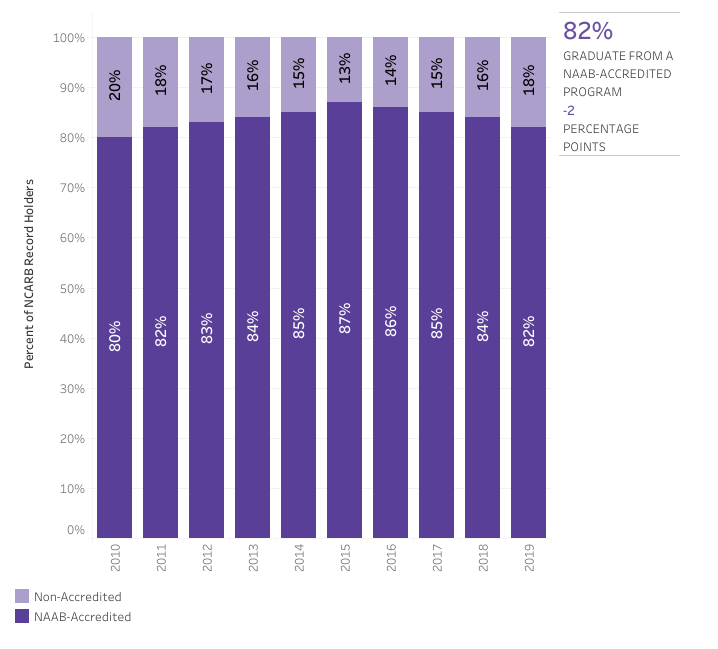
In a reversal of a historic trend, graduates of non-accredited programs completed the national licensing exam some 4 months sooner than students with degrees from NAAB-accredited institutions, although with slightly less success: a 48—compared to 54—percent pass rate.
Accredited schools saw a 2 percent increase in matriculation compared to the prior academic year—some 7,700 students, evenly divided between men and women, and split 48 percent to 51 percent between B.Arch. and M.Arch. programs. In total, just over 26,000 students were enrolled in a NAAB-accredited program—the highest numbers since 2013. Of those students, 51 percent were men, and 49 percent women. Gender parity of graduates, however, declined by 1 percentage point from last year; 53 percent of the 5,985 degrees conferred went to men, and 47 percent to women.
Gender representation and diversity increased among candidates who completed the Architectural Experience Program (AXP)—the second prong of the core requirements—in 2019: the proportion increased by 2 percentage points for women, to 42 percent, and by 3 percentage points for people of color, to 37 percent. (The increase in non-white candidates was largely seen among those of Asian and Hispanic or Latino heritage, with almost no change in the proportion of African American individuals.)
Exam Completion and New Certificates
The number of Architect Registration Examination (ARE) completions—the third requirement of the process—fell by 21 percent to 3,909, with the average candidate taking one month longer (2.3 years) to complete the six-part test and the average pass rate dropping by 2 percent. While NCARB cited the transition from ARE 4.0 to ARE 5.0 as the cause, the organization also noted that “examination experts are constantly evaluating the exam to ensure it remains fair and appropriate.”
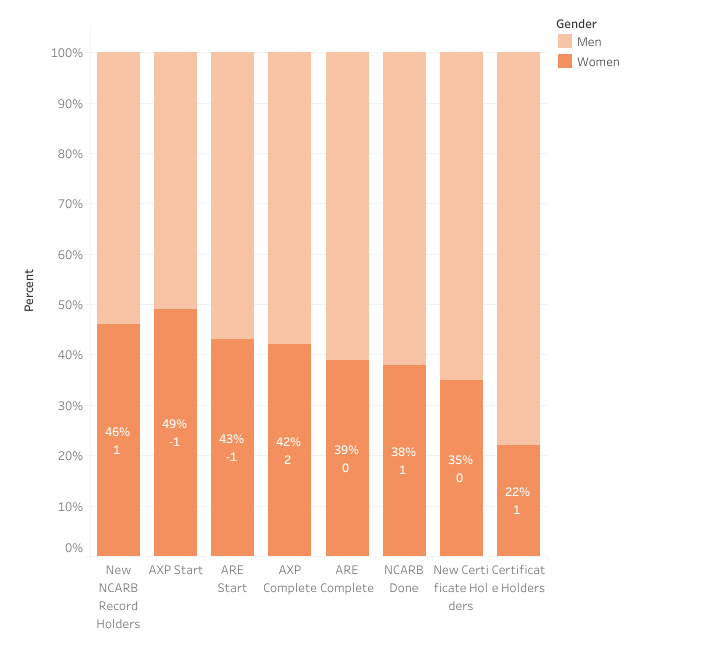
Women represented 39 percent of all those who completed the ARE in 2019—the same proportion as the prior year, and highest level on record. They also comprised 38 percent of candidates who finished all core licensure requirements (up 1 percentage point from 2018), doing so, on average, in 11.9 years—1.3 years sooner than their male counterparts. Women made up 35 percent of new NCARB certificate holders last year, the same as the in 2018, and 22 percent of certificate holders overall—one percentage point higher than the previous year.
Non-white candidates comprised 21 percent of those who completed the ARE and all core requirements last year, and 16 percent of new NCARB certificate holders—an increase of 2 percentage points. People of color represented 11 percent of certificate holders overall. (Broken down further, 6 percent of all certificate holders identified as Asian; 2 percent as Black; and 3 percent as another non-white, non-Hispanic or Latino race or ethnicity.)
Diversity
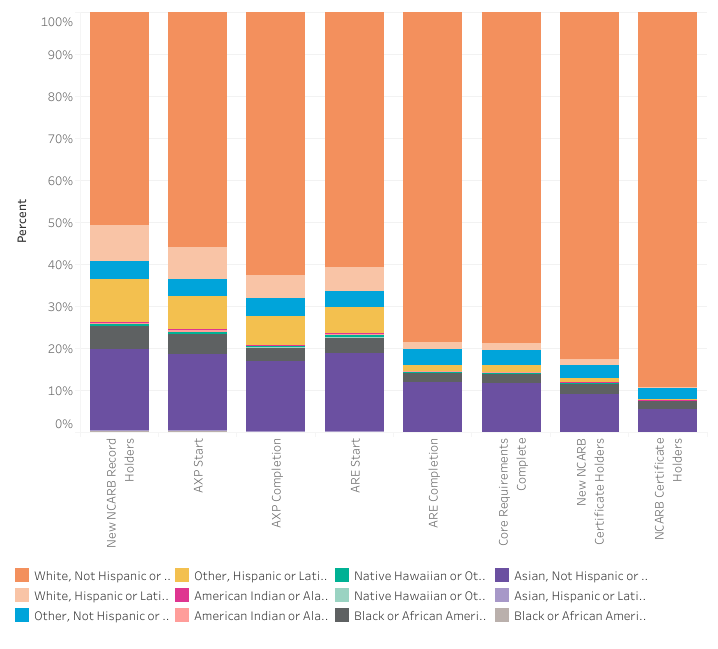
With more detailed demographic information available this year than in the past, the 2020 report showed that fewer than two in five architects are women, and fewer than one in five identifies as a racial or ethnic minority. Women in the profession are more diverse than men at every career stage, with over half who started down the road to licensure in 2019 identifying as a racial or ethnic minority. However, early in the path to licensure, the proportion of Black men starting the experience program exceeds that of Black women, 6 percent to 4 percent. This finding, especially when compared with data from the joint NOMA/NCARB survey conducted earlier this year, suggests “that there may be additional barriers preventing African American women from progressing in the profession,” says the NCARB report.
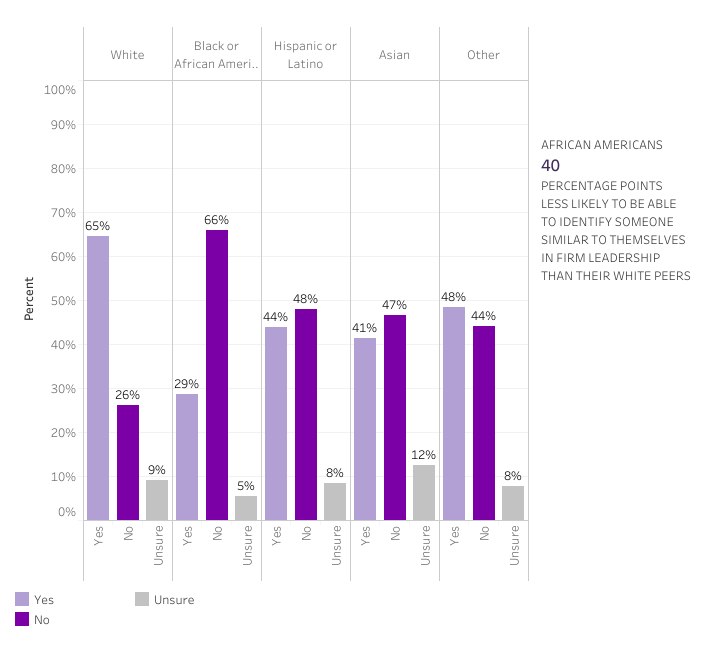
While NCARB and NOMA will continue to analyze the results of their joint survey—to which some 5,000 professionals replied in full—early results indicate “there is often slight, but widespread, disparity throughout the licensure process and in firm culture,” with women of color and Black professionals particularly affected.
Two-thirds of African American survey participants reported they could not identify leaders at their firm who are similar to themselves—a sentiment shared by only 26 percent of white respondents—and 40 percent said they have faced or witnessed discrimination in the workplace. Half of all people of color who were surveyed reported that they decided to stop pursuing licensure “while working at an architecture firm”—a proportion 7 percentage points higher than their white counterparts.
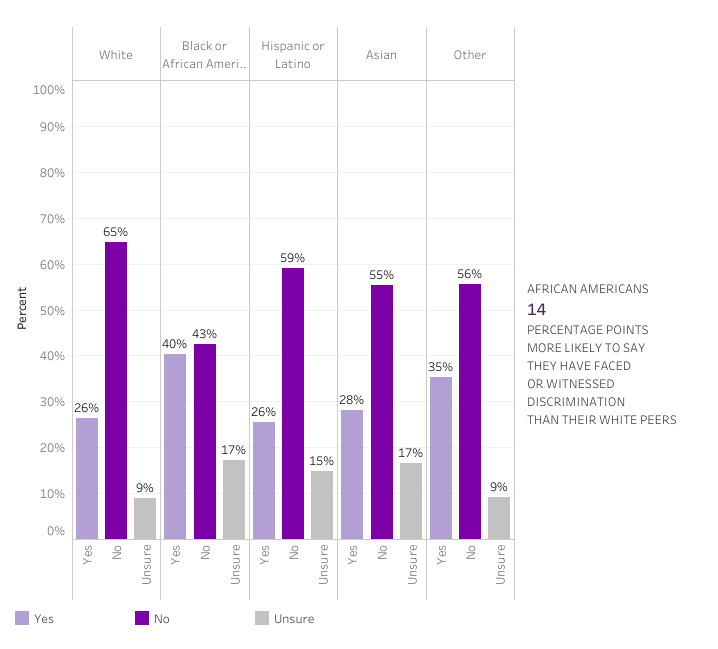
Given the disparities in work experiences, NCARB calls the higher level of attrition of people of color “understandable, and potentially preventable,” adding that such findings “highlight the need for culture and systematic shifts throughout the profession.”






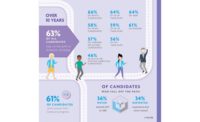

Post a comment to this article
Report Abusive Comment